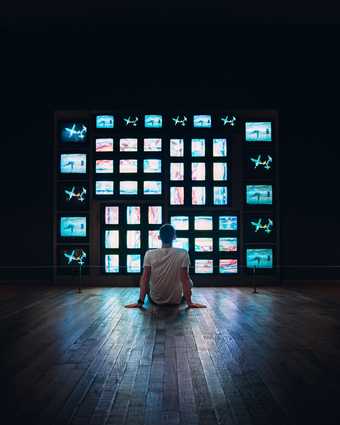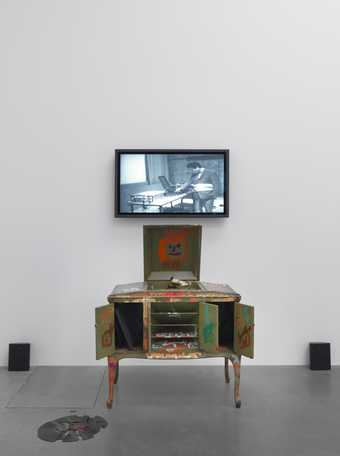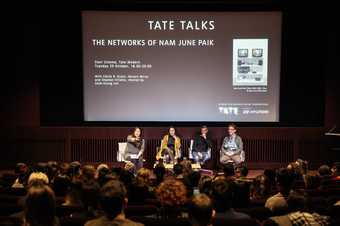
Sook-Kyung Lee, Cécile B. Evans, Haroon Mirza and Stephen Vitiello in the panel discussion ‘The Networks of Nam June Paik’, Tate Modern, 29 October 2019
© Guillaume Valli
The curators of the Nam June Paik retrospective on display at Tate Modern (17 October – 9 February 2019) have avoided a chronological approach to the presentation of Paik’s work. Instead, the exhibition is structured around the South Korean artist’s various transnational and cross-cultural encounters with other artists and ideas, allowing visitors to piece together a vision of Paik’s ‘network’. An accompanying panel discussion, held on 29 October 2019 and aptly named ‘The Networks of Nam Jun Paik’, extended this network into the present day, bringing together three contemporary artists to discuss Paik’s influence on their art practice and his wider artistic legacy. Invited to speak were Stephen Vitiello, a sound and visual artist who collaborated with Paik in the 1990s; Haroon Mirza, a self-described ‘composer’ whose installations and kinetic sculptures test the boundaries between noise, sound and music; and Cécile B. Evans, whose video installations examine the intersections between emotions, ideology and technology. After briefly sharing their first experiences of Paik and his work, the speakers each gave a short presentation and then took part in a panel discussion, with questions taken from the audience. By focusing on artists’ responses, the event offered an alternative way of approaching Paik’s work to the one taken by the exhibition’s curators. It also raised compelling questions about influence, legacy and the effects of new technologies on art and artists’ networks, although these questions were not always answered.
Sook-Kyung Lee, Senior Curator of International Art at Tate and one of the exhibition’s curators, chaired the discussion. She laid out the panel’s aim: to allow room for Paik’s ‘artistic legacy’ to emerge by lending an ear to artists’ voices, specifically. Artists’ thoughts on the work of other artists tend to be sidelined in art writing in favour of other perspectives – that of the curator, critic or museum visitor, for example. For their part, as Evans observed, artists are often loath to discuss influence, legacy and heritage, perhaps because of the art world’s enduring emphasis on originality and genius. Where influences are discussed, it has often been the role of the curator, critic or historian to draw connections between artists and elaborate on or complicate the art historical signposts provided by artists themselves. By focusing on artists’ perspectives, the panel shed light on experiences of art and influence that are frequently glossed over and which artists are best placed to speak about.
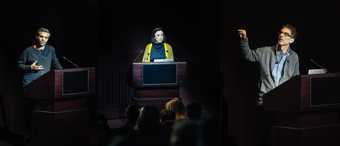
Haroon Mirza, Cécile B. Evans and Stephen Vitiello giving individual presentations as part of ‘The Networks of Nam June Paik’, Tate Modern, 29 October 2019
© Guillaume Valli
One thread that emerged from the evening’s conversation was the idea of an artist’s influence and legacy as a story based on personal processes of remembering, misremembering and forgetting, and which often only materialises by looking back. Mirza, whose first encounter with Paik’s work was on a visit to New York as an art student, described its impact on his practice as ‘serendipitous’ and unconscious: it is only by viewing Paik’s work again, Mirza asserted, that he is able to perceive an influence. Evans, meanwhile, noted that she was initially unsure why she had been invited to speak, suggesting that the links she drew in her presentation between Paik’s approach to art and her own were not obvious to her to begin with. Instead, these links emerged somewhat artificially, by piecing together a narrative from her encounters with Paik’s work in books and museums and from the concerns and approaches that the two artists share. Responding to a question from the audience during the panel discussion, she rejected the narrative trope of the ‘first encounter’ as a transformative experience. Instead she offered a more nuanced account of influence as a process in which many different experiences and ideas accumulate in a mental ‘archive’, later called upon and combined to solve creative problems in the course of making art. Vitiello, who knew Paik personally, touched upon the ‘legends’ spun about Paik by himself and others – particularly the story of Paik being the first person in the US to purchase the Sony Portapak, a self-contained battery-powered camera system, and screening the footage he had recorded at New York’s Café Au Go-Go the same evening as his purchase. Whether fact or fiction, Vitiello added, these tales of Paik’s ingenuity and curiosity remain ‘evocative’ as sources of inspiration and influence for artists like himself.
Indeed, every story has its characters, and much of the inspiration that the speakers drew from Paik was related to his personality, or their perceptions of it. The colourful anecdotes of run-ins and collaborations with Paik that Vitiello shared painted a picture of an inquisitive and somewhat irreverent character with ‘childlike curiosity’ for the ‘magic’ of art and technology. All three artists found in Paik’s example the ‘license’ to traverse different types of boundary. Both Evans and Vitiello spoke of the permission they felt they needed to cross the threshold of the art world – to begin thinking of themselves as artists, and not, to use Evans’s word, as ‘imposters’. Mirza, the only one of the three artists to have received a formal art education, talked about the permission he needed to take the knowledge gained from his training in visual art and push it into the realm of the acoustic – just as Paik, trained as a musician, had done the opposite.
Discussions of an artist’s ‘personality’ or ‘spirit’ typically risk perpetuating an image of the artist as a genius, implicitly gendered as a man. This is particularly relevant in the case of Paik, who is often referred to as ‘the father of video art’.1 The evening’s discussion did not sufficiently call into question the way that Paik is remembered. However, Evans came closest to critiquing this, citing as another influence on her work the video artist Shigeko Kubota, whose work is often overshadowed by her husband’s – Paik himself.
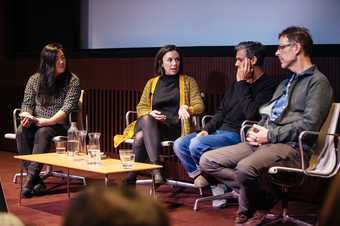
Sook-Kyung Lee, Cécile B. Evans, Haroon Mirza and Stephen Vitiello in the panel discussion ‘The Networks of Nam June Paik’, Tate Modern, 29 October 2019
© Guillaume Valli
Of all the speakers, the relationship between Paik’s work and Evans’s emerged the most concretely. This is unsurprising given that, of the invited artists, Evans works the most often with video – the medium Paik, an interdisciplinary artist, is best known for using. Evans’s comments also foregrounded technological and cultural shifts since Paik’s time which shape artistic engagements with technology today. Evans operates in a world in which our widespread entanglement with the digital – optimistically anticipated in Paik’s early work – has become axiomatic. Evans’s 2014 work AGNES is a spam bot running on scripted code that ‘lives on the internet’, sharing personal information, giving interviews, sending gifts, and even composing video essays. AGNES highlights the new levels of connectivity and exchange between humans and machines made possible by digital networks developed since Paik’s satellite installation Good Morning Mr. Orwell. First broadcast on New Year’s Day in 1984, Good Morning Mr. Orwell consisted of live and taped video segments from across the world. Though Evans typically adopts a more cautious and critical tone than Paik towards data and the digital, and their connection to what writer and academic Shoshana Zuboff has called ‘surveillance capitalism’,2 her interest in the emancipatory possibilities of alternative digital realities is very reminiscent of Paik’s vision, as she noted.
The panel discussion was warm, informal and generous, bringing to the fore the ways that Paik’s experimental and collaborative approach to art and technology have been inspirational for younger artists working today. However, more space could have been created to reflect on the limitations of the panel and its stated aims, particularly given Paik’s (and Mirza’s and Evans’s) interest in the productivity of glitches and breakdowns. At the beginning of the evening Lee introduced the three speakers as belonging to different generations, but no meaningful distinctions along the lines of age emerged, complicating generational thinking (and in any case, only six years separate Mirza and Evans). The discussion could also have touched upon the implications of new technologies and the digital for transnational networks of artists today. There might have been room, too, to address the fact that all three artists were from Europe and North America and to reflect on how this may have shaped their impressions of Paik’s work and legacy.
Something else that might be a valuable avenue of investigation is a discussion of ‘legacy’ itself. How or by whom, for example, is a legacy formed and framed? Or, to use the metaphor of the event’s title, how is the artist’s network channelled? Here, Paik is one character in the story; so are the artists and curators who draw from and present his work, both of whom shape its possible meanings and reception. The panel could also have considered in more depth the role played by organisations like the artist’s estate and the Nam June Paik Art Center in Seoul (to which Mirza and Evans have links) in shaping Paik’s transnational legacy and choosing which artists are called to represent it and why.
Legacy also has another meaning pertaining to information technology, which is felicitous given Paik’s interests. The word can refer to hardware or software that has been superseded by newer versions but continues to be used. Paik’s television sets, and even his optimistic outlook towards technology, may on the surface appear outdated now. But the conversations that were had over the course of the evening demonstrated the ways that Paik’s curious and playful approach to technology and art continue to be instrumental for artists working today, and that his ‘networks’ continue to extend, by whatever means, through time and space.

